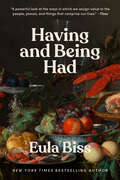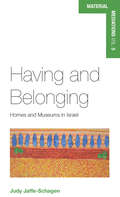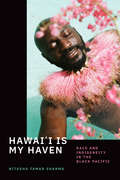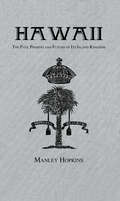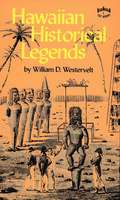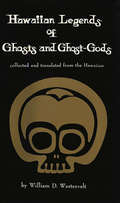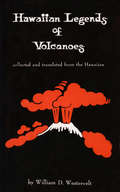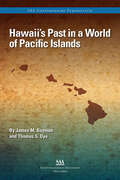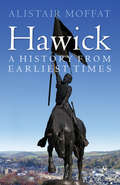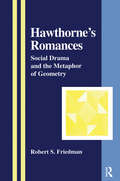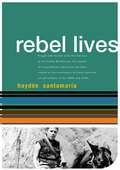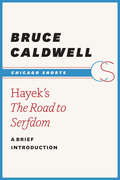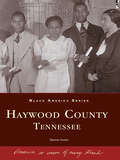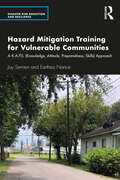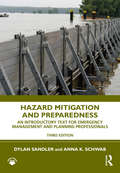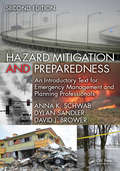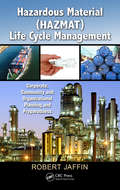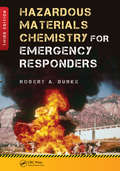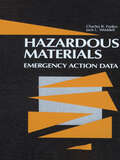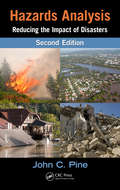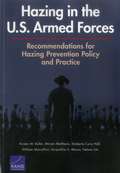- Table View
- List View
Having and Being Had
by Eula BissA timely and arresting new look at affluence by a New York Times bestselling author.&“My adult life can be divided into two distinct parts,&” Eula Biss writes, &“the time before I owned a washing machine and the time after.&” Having just purchased her first home, she now embarks on a roguish and risky self-audit of the value system she has bought into. The result is a radical interrogation of work, leisure, and capitalism. Described by The New York Times as a writer who &“advances from all sides, like a chess player,&” Biss brings her approach to the lived experience of capitalism. Playfully ranging from IKEA to Beyoncé to Pokemon, across bars and laundromats and universities, she asks, of both herself and her class, &“In what have we invested?&”
Having and Belonging: Homes and Museums in Israel
by Judy Jaffe-SchagenThe home and the museum are typically understood as divergent, even oppositional, social realms: whereas one evokes privacy and familial intimacy, the other is conceived of as a public institution oriented around various forms of civic identity. This meticulous, insightful book draws striking connections between both spheres, which play similar roles by housing objects and generating social narratives. Through fascinating explorations of the museums and domestic spaces of eight representative Israeli communities-Chabad, Moroccan, Iraqi, Ethiopian, Russian, Religious-Zionist, Christian Arab, and Muslim Arab-it gives a powerful account of museums' role in state formation, proposing a new approach to collecting and categorizing particularly well-suited to societies in conflict.
Hawai'i Is My Haven: Race and Indigeneity in the Black Pacific
by Nitasha Tamar SharmaHawaiʻi Is My Haven maps the context and contours of Black life in the Hawaiian Islands. This ethnography emerges from a decade of fieldwork with both Hawaiʻi-raised Black locals and Black transplants who moved to the Islands from North America, Africa, and the Caribbean. Nitasha Tamar Sharma highlights the paradox of Hawaiʻi as a multiracial paradise and site of unacknowledged antiBlack racism. While Black culture is ubiquitous here, African-descended people seem invisible. In this formerly sovereign nation structured neither by the US Black/White binary nor the one-drop rule, nonWhite multiracials, including Black Hawaiians and Black Koreans, illustrate the coarticulation and limits of race and the native/settler divide. Despite erasure and racism, nonmilitary Black residents consider Hawaiʻi their haven, describing it as a place to “breathe” that offers the possibility of becoming local. Sharma's analysis of race, indigeneity, and Asian settler colonialism shifts North American debates in Black and Native studies to the Black Pacific. Hawaiʻi Is My Haven illustrates what the Pacific offers members of the African diaspora and how they in turn illuminate race and racism in “paradise.”
Hawaii: The Past, Present and Future of Its Island
by Manley HopkinsFirst published in 2005. This account by this well known literary figure of the nineteenth century is a most informative and remarkable introduction to this subject of abiding interest and universal appeal. Though not generally known, Manley Hopkins, in addition to this considerable literary endeavor, was also the Hawaiian Consul-General in Liverpool during the mid-nineteenth century.
Hawaii: The Past, Present, And Future Of Its Island-kingdom
by Manley HopkinsFirst published in 2005. Routledge is an imprint of Taylor & Francis, an informa company.
Hawaiian Historical Legends
by William D. WesterveltThis literary treasure provides one of the earliest glimpses into pre-colonial Hawaaiin culture.This book, one of six written by Dr. Westervelt, is a fascinating compilation of Hawaiian legends and historical tales. The origins of the Hawaiian people, the demi-god Maui's search for immortality for mankind, the coming of Captain Cook, the wars of King Kamehameha, as well as other aspects of Hawaii's incredible history fill its pages. Librarians, students, collectors, and anyone who enjoys reading about ancient Hawaii will delight in Hawaiian Historical Legends. Dr. Westervelt is one of the best-known raconteurs of Hawaiian stories.Hawaiian Historical Legends presents a variety of stories both legendary and historical. The author also considers the question of Polynesian origins and the speculative subject of Spanish visitants.Other titles n this series on Hawaii include: Hawaiian Legends of Ghosts and Ghost Gods, and Hawaiian Legends of Old Honolulu Hawaiian Legends of Volcanoes.
Hawaiian Legends of Ghosts and Ghost-Gods
by William D. Westervelt1916. A diverse collection of the legends of the Hawaiian Islands. Contents Part I-Legends: The Ghost of Wahaula Temple; Maluae and the Underworld; A Giant's Rock Throwing; Kalo-Eke-Eke, The Timid Taro; Legendary Canoe Making; Lau-Ka-Ieie; Kauhuhu, the Shark God of Molokai; The Shark Man of Waipio Valley; the Strange Banana Skin; The Old Man of the Mountain; Hawaiian Ghost Testing; How Milu Became the King of Ghosts; A Visit to the King of Ghosts; Kalai-Pahoa, the Poison God; Ke-Ao-Mele-Mele, the Maid of the Golden Cloud; Poona and the Dragon; Ke-Au-Nini; and The Bride from the Underworld. Part II- Description: The Deceiving of Kewa; Homeless and Desolate Ghosts; Aumakuas or Ancestor Ghost Gods; The Dragon Ghost Gods; and Home of the Ancestors.
Hawaiian Legends of Volcanoes
by William D. Westervelt"A richly entertaining series of Hawaiian tales with explanatory facts, which will delight and inform both the folklore fan and the general reader..." -The Honolulu AdvertiserHawaiian Legends of Volcanoes made its first appearance in 1916, in both American and British editions, as the third in a series that represented a pioneering study of Hawaiian folklore. The rich tradition of Hawaiian legends is showcased in it's purest form, making this an essential read for anyone living in Hawaii who wants to understand the local culture or anyone interested in classical folklore. The book also includes a study of Hawaiian geology, which is essential to understanding how the Hawaiian religion and classical Hawaiian stories developed.Legends and stories include: Ai-Au, The Forest Eater Pele and the Owl Ghost-God Hiiaka's Battle with the Demons The Annihiation of Keoua's Army Kapiolani and Pele and many more...Other volumes in the series about Hawaiian culture and history are Hawaiian Legends of Ghosts and Ghost-Gods and Hawaiian Legends of Old Honolulu.
Hawaii’s Past in a World of Pacific Islands: Past In A World Of Pacific Islands (SAA Current Perspectives)
by James M. Bayman Thomas S. DyeGiven its relatively late encounter with the West, Hawaii offers an exciting opportunity to study a society whose traditional lifeways and technologies were recorded in native oral traditions and written documents before they were changed by contact with non-Polynesian cultures. This book in the SAA Press Current Perspectives Series chronicles the role of archaeology in constructing a narrative of Hawaii’s cultural past, focusing on material evidence dating from the Polynesians’ first arrival on Hawaii’s shores about a millennium ago to the early decades of settlement by Americans and Europeans in the nineteenth century. A final chapter discusses new directions taken by native Hawaiians toward changing the practice of archaeology in the islands today.
Hawick: A History from Earliest Times
by Alistair MoffatThis local history tells the centuries-long story of a Scottish Borders town through its battles, traditions and transformations from prehistory to today. Hawick, Scotland, is famous for its annual Common Riding festival, an equestrian tradition that traces its roots to the 16th century Battle of Hornshole. But in this lively history, Alistair Moffat takes the narrative much further back into the mists of prehistory, to the time of the Romans, the coming of the Angles and the Normans. Moffat recounts how Hawick got its name, where the old village stood, and who the early barons of Hawick were. He then charts the amazing rise of the textile trade, bringing the story up to the present day. Hawick has changed radically over the many centuries since people began to live between the Slitrig and the Teviot. All that experience in one place has created a rich cultural heritage, one which the people of Hawick proudly carry into the future.
Hawthorne's Romances: Social Drama and the Metaphor of Geometry (The Library of Anthropology #Vol. 15)
by Robert S. FriedmanFirst Published in 2000. Routledge is an imprint of Taylor & Francis, an informa company.
Haydée Santamaría
by Betsy MacleanHaydée first achieved notoriety by being one of the two women who participated in the armed attack that sparked the Cuban Revolution. Later, as director of the world renowned literary institution, Casa de las Americas, she embraced culture as a tool for social change and provided refuge for exiled Latin American artists and intellectuals. Included are reflections by Alicia Alonso, Mario Benedetti, Ariel Dorfman, Melba Hernandez, Roberto Fernandez Retamar and Silvio Rodriguez.
Hayek and Praxeology
by Adam KnottOne of the pillars of Hayekian social thought is Hayek's contention that study of the market cannot be a priori. But Hayek seems not to have realized the implications of his own conception of the Pure Logic of Choice. He didn't realize that the method of deductive analysis he envisioned could easily be applied to the market and its various objects and phenomena (prices, interest, etc.).
Hayek's The Road to Serfdom: A Brief Introduction (Chicago Shorts)
by Bruce CaldwellThe Road to Serfdom, F. A. Hayek's 1944 warning against the dangers of government control, continues to influence politics more than seventy years after it was turned down by three American publishers and finally published by the University of Chicago Press. A classic work in political philosophy, intellectual and cultural history, and economics, the definitive edition of The Road to Serfdom included this essay as its Introduction. Here, acclaimed Hayek biographer and general editor of the Collected Works of F. A. Hayek series, Bruce Caldwell explains how Hayek came to write and publish the book, assesses misunderstandings of Hayek's thought, and suggests how Hayek's fears of Socialism lead him to abandon the larger scholarly project he had planned in 1940 to focus instead on a briefer, more popular and political tract--one that has influenced political and economic discourse ever since.
Haywood County, Tennessee (Black America Series)
by Sharon NorrisSurviving slavery, Reconstruction, poverty, and the Civil Rights tensions of the twentieth century, Haywood County's black community has done much to shape the identity of this historic West Tennessee county. This volume, containing over 200 black-and-white images, highlights the county's settlement, the early slave culture, the legacy of its many soulful and talented musicians, such as Anna Mae Bullock (better known as Tina Turner), the hard-fought strides in bringing education to African-American citizens, the importance of church inmolding the social and spiritual elements of life, and some of the county's most recognizable faces and names.
Hazard Mitigation Training for Vulnerable Communities: A K.A.P.S. (Knowledge, Attitude, Preparedness, Skills) Approach (Disaster Risk Reduction and Resilience)
by Joy Semien Earthea NanceThis book is designed to educate vulnerable communities, emergency practitioners, and disaster researchers to increase the social and physical capacity of communities to mitigate and adapt to disaster impacts. With climate change escalating the intensity and range of disasters, we have entered an unprecedented time. The tools in this book allow researchers, practitioners, and community leaders to adopt new training techniques that are more engaging and effective, using a bottom-up framework to integrate knowledge, attitude, preparedness, and skills (K.A.P.S). This book is uniquely designed to support instructors, researchers, practitioners, and community leaders in their effort to promote preparedness across marginalized communities. The book contains a full range of templates, worksheets, survey questions, background information, and guidance for carrying out training; the material has been field-validated to meet research standards. The K.A.P.S. Framework outlined throughout the book is designed to serve as an adaptable model that national and international audiences can utilize to better prepare their communities for disasters due to hurricanes, floods, and tornadoes. As climate change continues to ravage communities, the K.A.P.S. training program will prove to be an important tool for community trainers and academics across a range of hazards and disasters.
Hazard Mitigation and Preparedness: An Introductory Text for Emergency Management and Planning Professionals
by Dylan Sandler Anna K. SchwabAn essential text for today’s emerging professionals and higher education community, the third edition of Hazard Mitigation and Preparedness provides accessible and actionable strategies to create safer, more resilient communities. Known and valued for its balanced approach, Hazard Mitigation and Preparedness assumes no prior knowledge of the subject, presenting the major principles involved in preparing for and mitigating the impacts of hazards in emergency management. Real-world examples of different tools and techniques allow for the application of knowledge and skills. This new edition includes: Updates to case studies and sidebars with recent disasters and mitigation efforts, including major hurricanes, wildfires, earthquakes, and the COVID-19 pandemic. Summary of the National Flood Insurance Program, including how insurance rates are determined, descriptions of flood maps, and strategies for communities to help reduce premiums for residents. Overview of the ways that climate change is affecting disasters and the tools that emergency managers can use to plan for an uncertain future. Best practices in communication with the public, including models for effective use of social media, behavioral science techniques to communicate information about risk and preparedness actions, and ways to facilitate behavior change to increase the public’s level of preparedness. Actionable information to help emergency managers and planners develop and implement plans, policies, and programs to reduce risk in their communities. Updated in-text learning aids, including sidebars, case studies, goals and outcomes, key terms, summary questions and critical thinking exercises for students. An eResource featuring new supplemental materials to assist instructors with course designs. Supplements include PowerPoint slides, tests, instructor lecture notes and learning objectives, key terms and a course syllabus.
Hazard Mitigation and Preparedness: An Introductory Text for Emergency Management and Planning Professionals, Second Edition
by David J. Brower Dylan Sandler Anna K. SchwabThis book introduces the concept of hazards as part of the earth's natural systems, in contrast to "disasters," which occur at the intersection of the built and natural environments. The authors emphasize choices made by society that either increase or diminish our level of vulnerability to the impacts of hazards and discusses the role of the emergency manager in how these choices are made and acted upon. The book defines key concepts including mitigation, preparedness, resilience, and vulnerability, and explains the role of the emergency manager in putting these principles into practice.
Hazardous Material (HAZMAT) Life Cycle Management: Corporate, Community, and Organizational Planning and Preparedness
by Robert JaffinIt is well known that fluorescent light bulbs and consumer appliances such as televisions, computers, and monitors contain mercury, dangerous chemicals, and other harmful components. The existing literature on hazardous materials addresses the risks attached to specific materials and emphasizes compliance and personal protective equipment (PPE) but
Hazardous Materials Chemistry for Emergency Responders
by Robert BurkeThe third edition of a bestseller, Hazardous Materials Chemistry for Emergency Responders continues to provide the fundamentals of "street chemistry" required by emergency response personnel. Emergency response and hazmat expert Robert Burke takes the basics of chemistry appropriate for response personnel and puts it into understandable terms. The
Hazardous Materials: Emergency Action Data
by Jack L. WeddellThis book is a reference guide that provides chemical, health, and safety information on more than 1,120 toxic and hazardous chemicals and lists nearly 3,000 synonyms used for the most commonly transported chemicals by railroad and highway carriers. Information comes straight from the manufacturers and can prove invaluable for first responders faced with a medium to large spill or fire.Chemical listings are presented alphabetically and include such information as the DOT designation, neutralizing agents, special warnings, chemical suit listings, emergency first aid, hazard ratings, fire fighting information, evacuation distances, health hazard information, threshold limit values. The manufacturer of each chemical and phone number to be used to obtain more information regarding the chemical is also provided. Enough information is presented in this guide that there is no longer a need to carry 10-15 reference books when responding to an incident.
Hazardous Substances in India and the World: Legislations, Frameworks and Management
by T. R. SubramanyaThis book examines the nature of hazardous substances and the law governing them, including international conventions, relevant directives and Indian legislation from the pre-independence period to the present. It focuses on legislations passed in the area of hazardous substances, highlighting the background relevant to the continued growth of international environmental law across the globe. It reviews existing strategies available in developing countries and the lack of a systematic approach in administering hazardous substances management programs. The author unfolds the dynamics of hazardous substances, the trade of such substances, transboundary movements and their restrictions through rigorous analyses and evaluation of cases. The book explores the question of liability in hazardous substance litigation, offers an understanding of several judicial decisions in the context, and suggests measures to control and manage the problem of hazardous substances. Authoritative, lucid and comprehensive, this book will be useful to students, researchers and policymakers working on environment, law, international environmental law and development studies, as well as to legal professionals, judicial officers and NGOs.
Hazards Analysis: Reducing the Impact of Disasters, Second Edition
by John C. PineThe impacts of natural and man-made disasters have increased exponentially over the past few decades. Moreover, with our global interconnectedness and the growing scale of disasters, today's catastrophic disasters can have regional, national, and even global economic consequences.Following in the tradition of the successful first edition, Hazards Analysis: Reducing the Impact of Disasters, Second Edition provides a structure and process for understanding the nature of natural and human-caused disasters. Stressing the role of hazard risk management for public, private, and nonprofit organizations, the author and expert contributors cover problem solving, risk analysis, and risk communications to ensure readers are in a position to identify key problems associated with hazards and the risks that they present.The book details a systematic process of hazards identification, vulnerability determination, and consequence assessment for the natural, built, and human environment. Using a cross-disciplinary approach, this book effectively demonstrates how to use the results of vulnerability assessment, spatial analysis, and community planning to reduce adverse disaster outcomes and foster social, economic, and environmental sustainability. Throughout, the book stresses that hazards analysis is not an isolated process but one that must engage the local community.Complete with clearly set objectives, key terms, discussion questions, satellite images and maps, and ancillary websites for further study, this authoritative guide covers every element of the hazard analysis process in a step-by-step format. Hazards Analysis presents time-proven strategies for building sustainable communities, identifying and prioritizing risks, and establishing successful disaster prevention and relief strategies prior to a disaster.
Hazel Brannon Smith: The Female Crusading Scalawag
by Jeffery B. HowellHazel Brannon Smith (1914-1994) stood out as a prominent white newspaper owner in Mississippi before, during, and after the civil rights movement. As early as the mid-1940s, she earned state and national headlines by fighting bootleggers and corrupt politicians. Her career was marked by a progressive ethic, and she wrote almost fifty years of columns with the goal of promoting the health of her community.In the first half of her career, she strongly supported Jim Crow segregation. Yet, in the 1950s, she refused to back the economic intimidation and covert violence of groups such as the Citizens" Council. The subsequent backlash led her to being deemed a social pariah, and the economic pressure bankrupted her once-flourishing newspaper empire in Holmes County. Rejected by the white establishment, she became an ally of the black struggle for social justice.Smith's biography reveals how many historians have miscast white moderates of this period. Her peers considered her a liberal, but her actions revealed the firm limits of white activism in the rural South during the civil rights era. While historians have shown that the civil rights movement emerged mostly from the grass roots, Smith's trajectory was decidedly different. She never fully escaped her white paternalistic sentiments, yet during the 1950s and 1960s she spoke out consistently against racial extremism. This book complicates the narrative of the white media and business people responding to the movement's challenging call for racial justice.
Hazing in the U.S. Armed Forces
by Nelson Lim Kimberly Curry Hall Kirsten M. Keller Jacqueline A. Mauro Miriam Matthews William MarcellinoThis report documents research focused on helping the Department of Defense build a more-systematic approach to hazing prevention and response. The report documents theory and research on the root causes of hazing and findings and recommendations regarding how best to define hazing, practices to prevent and respond to incidents of hazing, and how the armed forces can improve the tracking of hazing incidents.
